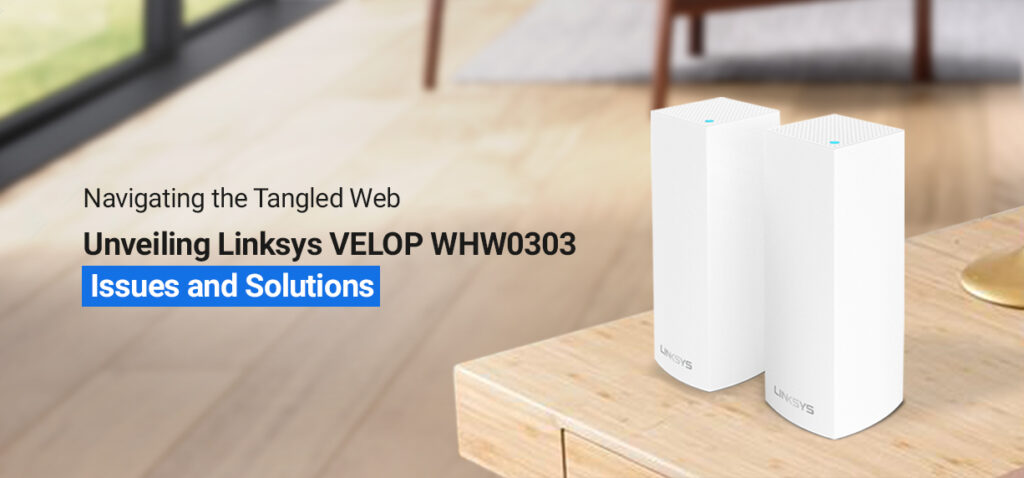In the ever-evolving landscape of home networking, the Linksys VELOP Whole Home Mesh WiFi System WHW0303 has emerged as a beacon of reliable connectivity. Yet, even the most advanced technology may encounter hiccups from time to time. In this blog post, we delve into the details of troubleshooting common issues with the Linksys VELOP WHW0303, ensuring that your mesh network sails smoothly through the digital waves. You will learn tips on resolving general velop router issues in no time.
Let’s get started!
Key Tips to Avoid Linksys Velop WHW0303 Setup Issues
Understanding Linksys VELOP Indicator Lights
Users can address common issues related to the Linksys VELOP indicator lights and maintain a stable and reliable mesh network. It’s important to perform the troubleshooting steps systematically, starting with the basics like power connections and gradually moving towards more advanced troubleshooting if needed.
- Issue: Red or Blinking Light on the Power Status Indicator
- Check if the power cable is securely connected to both the router and the power outlet.
- Try using a different power outlet to rule out an issue with the current outlet.
- If the issue persists, test the power adapter with another compatible device or contact Linksys support for assistance.
2. Issue: Amber or Blinking Light on the Internet Connectivity Indicator
- Ensure that your modem is properly connected to the router, and both devices are powered on.
- Check the modem for any issues by connecting a computer directly to it.
- Reboot both the modem and the router, allowing them to establish a fresh connection.
- Verify that your internet service provider (ISP) is not experiencing any outages in your area.
3. Issue: Red or Off Light on the Node Connection Indicator
- Confirm that the node is powered on and properly connected to the main router or another node.
- Check for physical obstructions or interference that may affect the signal between nodes.
- Reboot the problematic node and wait for it to reconnect to the mesh network.
- If the issue persists, consider repositioning the nodes to optimize connectivity, ensuring they are within an optimal range of each other.
Place your Linksys VELOP Nodes Optimally
A key factor in maximizing the efficiency of the Linksys VELOP WHW0303 lies in strategically placing its nodes for optimal mesh networking. Troubleshooting common issues related to node placement can significantly enhance signal strength and overall network performance.
If you experience a weak or inconsistent signal, reevaluate the central location of nodes. Ensure they are strategically placed in central areas to provide uniform coverage. Adjust node positions to address dead zones and improve signal distribution.
For persistent dead zones, check for physical obstacles like walls or large furniture that may obstruct the signal. Reposition nodes to minimize interference and enhance coverage, ensuring a more comprehensive network reach.
Verify the connectivity of each node by confirming secure power connections and stable connections to the main router or other nodes. Troubleshoot any connectivity issues by checking cables and power sources.
Making the latest Linksys VELOP WHW0303 Firmware Updates
Like any sophisticated piece of technology, the VELOP system evolves with firmware updates. Head to the official Linksys website to download and install the latest firmware updates. Doing so will help you keep your device in the best of its health. Since firmware updates bring the latest feature enhancements, bug fixes, and more to the device, updating the Linksys Velop firmware regularly will help you keep your home network in the best shape as well.
Removing Interference from the Network
In the crowded airspace of Wi-Fi signals, interference can be a common nemesis. Identify potential interference sources using Wi-Fi analyzer tools. This may include other Wi-Fi networks, cordless phones, or microwave ovens. Choose channels with less interference or relocate nodes away from electronic devices. Ensure nodes are positioned within an optimal range of each other. Nodes that are too close may interfere, while those too far apart can result in signal degradation. Experiment with node spacing to find the optimal configuration.
Advanced Troubleshooting Tips
For the tech-savvy users seeking a deeper understanding, these advanced troubleshooting techniques can help:
Node-specific Diagnostics
- Regularly check the diagnostic information for each node, especially after any network changes or additions.
- Pay attention to signal strength variations and connectivity statuses to identify potential issues early on.
Signal Heatmaps
- Create signal heatmaps periodically to visualize changes in signal strength over time.
- Use heatmaps when adding new devices or repositioning nodes to ensure optimal coverage throughout your home.
Network Analysis
- Use packet sniffing selectively and only when necessary, as it involves a deeper level of network monitoring.
- Look for unusual patterns or spikes in data traffic that might indicate network congestion or irregularities.
Bandwidth Monitoring
- Regularly monitor bandwidth usage to identify data-hungry devices or applications.
- Adjust QoS settings based on bandwidth analysis to ensure priority for critical activities.
Debugging Console Access
- Before accessing the debugging console, familiarize yourself with the Linksys VELOP documentation to understand the available commands and features.
- Use the console for targeted investigations, such as checking for firmware updates or identifying specific error messages.
Channel Optimization
- Periodically check for interference from neighboring networks and adjust channel assignments accordingly.
- Be cautious when manually changing channels, as certain adjustments may impact network stability.
Quality of Service (QoS) Configuration
- Prioritize critical devices or applications by adjusting QoS settings based on your usage patterns.
- Regularly review and update QoS configurations to adapt to changes in network traffic.
The Final Word
In the ever-connected world we inhabit, the Linksys VELOP Whole Home Mesh WiFi System WHW0303 stands as a testament to seamless connectivity. If problems persist, reaching out to Linksys customer support at our end for further assistance is always a viable option.
